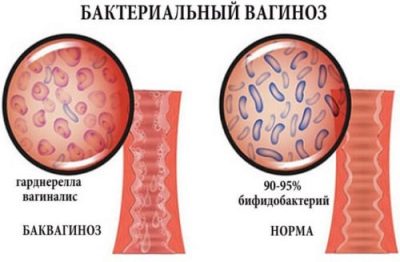Yellow discharge during early pregnancy
The appearance of specific secretions during pregnancy can spoil the mood of almost every expectant mother. This leads many women to real horror. This article will help to understand the peculiarities of the appearance of yellow discharge from the genital tract in early pregnancy.
Option norm
The emergence of discharge, having a yellow color, can contribute to various causal factors. Immediately it is worth noting that the appearance of this symptom is not always a manifestation of any pathology. It also happens that yellowish discharge is an individual feature of even a physiologically proceeding pregnancy. To understand this, it should be noted the main features of the appearance of such secretions.
Vaginal secretion of each woman has its own unique features. Its color may also vary. It is possible to consider such secretions as normal in early pregnancy if they are:
- have cream or pale yellow color;
- scanty or minor;
- no unpleasant smell;
- they are not accompanied by the development of uncomfortable symptoms in the area of the external genital organs (there is no itching, redness and severe dryness in the vagina).
The appearance of such specific yellowish secretions may also indicate changes occurring in the female hormonal background.
In the early stages of pregnancy, the level of hormones in the blood is constantly changing. This is a prerequisite for the growth and development of a small embryo that is in the uterus.
The increase in blood concentration of progesterone - the main hormone of pregnancy - is often accompanied by the fact that the vaginal discharge from a woman changes. This changes not only their color, but also the consistency. Such physiological vaginal discharge, as a rule, a little.
The causes of the development of pathological secretions
In some cases, the appearance of yellow secretions from the genital tract is already a sign of the manifestation of a particular pathological condition. In this situation, it is very important to find out in time what kind of cause affected the development of this unfavorable symptom.
Pathological vaginal discharge usually have a number of features. So, they are distinguished by bright colors, have an unpleasant smell, and also, as a rule, are accompanied by the development of associated adverse symptoms.
Candidiasis
Various diseases of the reproductive female organs can lead to the appearance of pathological secretions. One of these diseases is candidiasis. This infection is characterized by an intense proliferation in the vagina of candidal fungi. Active reproduction of these microorganisms leads to a change in the vaginal environment, which contributes to the appearance of specific secretions.
It is considered that candidal secretions have a cheesy appearance and a predominantly white color. In most cases, this is true, but there are still some exceptions. So, in some cases, candidiasis is manifested by the appearance of creamy yellow and white-yellow discharge. They usually have an unpleasant, even sour smell.Aggravates the general condition of a pregnant woman and the fact that candidal discharge from the genital tract, as a rule, is accompanied by the development of severe itching in the vagina.
Vaginal candidiasis is quite often manifested during pregnancy. It can develop both in the early and in some cases in the later periods. The development of genital tract candidiasis is largely promoted by a physiological decrease in immunity in a pregnant woman.
Bacterial vaginosis
The development of this pathology in early pregnancy, unfortunately, is not uncommon. Reduced immunity also contributes to the rapid bacterial growth of the vaginal mucosa. The increase in the number of microbes and contributes to the fact that there are specific discharge.
Initially they are grayish in color. Gradually, as the disease progresses, vaginal secretions change color and become bright yellow. A characteristic sign of discharge from the genital tract is the presence of a characteristic unpleasant smell. Often, doctors compare it with the smell of "rotten" fish. The appearance of yellow discharge is also accompanied by severe itching, which brings pronounced discomfort to the woman.
Many women try to cope with these adverse symptoms by resorting to the use of various methods of traditional medicine. Note that doing this during pregnancy is extremely cautious.. Some of these remedies may cause allergies. In this case, the adverse symptoms will only worsen.
Treatment of bacterial vaginosis, which developed in the first half of pregnancy, is best done in conjunction with a doctor.
Inflammatory diseases of the genital tract
Inflammation of the reproductive organs often leads to the fact that a woman has a variety of discharge. Chronic inflammatory diseases of the female genital organs are also accompanied by the development of edema, itching and burning. These symptoms significantly affect the future mother's state of health.
Many women wonder why it is during pregnancy that some chronic diseases are most often exacerbated. The answer is quite simple. The physiological decline in the work of the immune system that occurs during pregnancy contributes to these exacerbations. Such a decrease in immunity is intended by nature. If this did not happen, the maternal organism simply rejected the fetus.
Discharges that appear during exacerbation of chronic diseases of the female genital organs may have very different colors. It can be either light yellow or dark yellow. This largely depends on the localization of damage, as well as on the severity of the developed pathology.
If the vaginal discharge becomes yellow-pink, then this may be a sign of some kind of erosive process. Bleeding areas appear at the site of erosion, which can bleed during any mechanical contact with them. Usually, vaginal secretions with small amounts of blood can appear when traumatizing cervical erosion. Also, a pinkish discharge may appear after transvaginal ultrasound or after having sex.
Treat exacerbation of chronic disease is necessary. For this, the future mother is drawn up a whole scheme of therapy. It necessarily includes drugs that act on the resulting inflammation in the genital tract.
This treatment is selected carefully. Some of the drugs can have an adverse effect on the fetus, so only safe drugs are chosen.
Infectious pathologies
These diseases develop as a result of various pathogenic microbes entering the female body. Staphylococci, streptococci, anaerobes - all these microbes can cause severe inflammation in the female intimate organs.One of the characteristic signs of an infectious pathology of the reproductive organs is the appearance of vaginal secretions. Their color can be very diverse. It largely depends on which pathogen caused the development of the disease.
Often, vaginal discharge becomes yellow-green. They are usually abundant and are accompanied by an unpleasant smell. The consistency of such secretions may be different. Usually they are rather cumbersome and poorly separated from the mucous. The appearance of yellow-green vaginal discharge may indicate infection with staphylococcal flora. In this case, the pathology rather quickly leads to the development of cervicitis or vaginitis. In this situation, in addition to the vaginal discharge, the woman also has itching and severe redness of the genitals.
To eliminate the adverse symptoms, antibiotics are required. Note that many of the antibacterial drugs can have a significant impact on the fetus. Doctors categorically prohibit the use of such funds at home, without prior medical appointments.
In the early stages of pregnancy, systemic antibiotics in the form of tablets and capsules can be used only when absolutely necessary. Evaluate the indications for prescribing antibacterial agents in tablets can only be a doctor. Thus, when the appearance of yellow-green discharge from the genital tract should first be a specialist. In this situation, the doctor will take smears from the genital tract, as well as conduct a full clinical examination. Only after such a diagnosis will the doctor determine the tactics of treatment.
Sexually Transmitted Infections
These infectious diseases also quite often lead to the appearance of specific secretions in pregnant women. They can have the most varied color - from yellow to brown. The danger of sexually transmitted infections is that they can significantly aggravate the course of pregnancy. Pathogenic microbes that are the causative agents of the disease, while entering the bloodstream and rapidly spread throughout the body of the future mother. The danger of such pathologies is that they can lead to infection of the fetus.
To prevent such diseases, you should remember the rules of their prevention. Unprotected intercourse with an infected partner can lead to infection. If even the first signs of such diseases appear, you should immediately consult a doctor.
Allergic Pathologies
Almost every mother who bears a baby can experience various manifestations of allergy. Even women who, prior to pregnancy, did not notice a high susceptibility to various allergens, may experience adverse symptoms. This is largely influenced by hormonal changes occurring in the body of a pregnant woman.
Allergies can also lead to vaginal secretions that are yellowish in color. They usually appear after wearing daily pads, using intimate hygiene products, and may also occur after bathing with a new shower gel. Manifested allergies in the intimate area is usually quite bright. In addition to the resulting yellow vaginal discharge, a woman may experience severe itching. Sometimes he is unbearable. In this case, as a rule, the mucous membranes of the genital tract are irritated and redden.
Adverse symptoms may appear within a few hours after contact with a new allergen. In some cases, before the development of such discomfort discharge, it takes several days.
The main component of the treatment of any manifestation of allergy is the mandatory exclusion of the effect of the provoking allergen. Thus, a woman should understand what could have caused such adverse symptoms. Once the cause is established, you must immediately stop contact with the allergen.
If, despite the exclusion of the allergen, the well-being of a pregnant woman does not improve, then she should consult a doctor. In this situation, the doctor will consider the appointment of antihistamines. The action of these drugs helps to cope with itchy crotch, swelling and redness.
For information on what should be alerted women, see the following video.

























